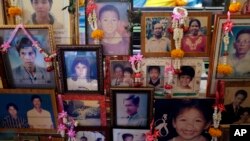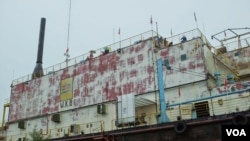December 26 marks the 10th anniversary of a powerful and deadly earthquake in the eastern Indian Ocean. It was the most powerful quake to hit the area in 40 years. The quake was so forceful it caused the Earth’s axis to move a few centimeters.
Scientists measured the quake as a magnitude nine. It caused an ocean wave, or tsunami, so big it destroyed entire coastal communities.
The deadly tsunami killed about 220,000 people- one-third of them children. The disaster left nearly 5 million people homeless. The disaster affected at least 12 countries. Indonesia was hardest hit by the tsunami, with more than 160,000 dead. Thousands more were killed in Thailand and Sri Lanka. The tsunami waves traveled as far as Africa.
Ten years later, VOA Correspondent Steve Herman reports from Banda Aceh, Indonesia.
All across beaches in Aceh, Indonesia, there are monuments, cemeteries and mass graves. One of these monuments marks the nearest point on land to where the massive undersea earthquake struck.
A woman named Salmi Hardiyanti lost 23 relatives. Like tens of thousands of other victims, their bodies were never found.
“I try to visit every mass grave in Banda Aceh to pray for them.”
Samsul Bahri’s wife was at their home just 20 meters from the beach when the waves hit. She and others near the beach were among the first to die.
An aid group rebuilt his house in the same location.
“I can’t afford to live anywhere else. So I had to come back here even though I’m afraid.”
Three kilometers from the coast is a monument that shows the force of the tsunami that destroyed a village. This monument is a huge 2,700-ton ship -- 69 meters long and 19 meters wide. This ship was making electricity offshore. The second tsunami wave moved the boat five kilometers from its position. It came to rest on top of two homes.
At a high school located in the area, only 60 of the 400 students survived the tsunami. A young man named Surya now goes to school there.
He was seven at the time of the disaster and lost 12 family members. International aid workers found him with a broken leg and other injuries.
He remembers trying to survive the deadly waves of the tsunami.
“Wherever we go, wherever we sit, wherever we run, death will eventually come. By the grace of Allah, we live and we die."
Many of the areas hit by the tsunami were underdeveloped. They struggled to recover from the disaster. But the international aid community responded quickly. Aid groups collected over $13 billion to aid in recovery and rebuilding efforts.
Scientists say destructive tsunamis have struck Indonesia before and will again. They warn that people living on the coast should always be prepared.
I’m Anna Matteo.
Steve Herman, VOA News, reports from Banda Aceh, Indonesia. Anna Matteo wrote his story for Learning English. Mario Ritter was the editor.
_____________________________________________________________
Words in This Story
monument – n. a structure, building or statue that honors a person or event
cemetery – n. a place for burial of the dead
destroy – v. to break into pieces; to end the existence of
tsunami – n. an extremely powerful ocean wave that results from an undersea earthquake









